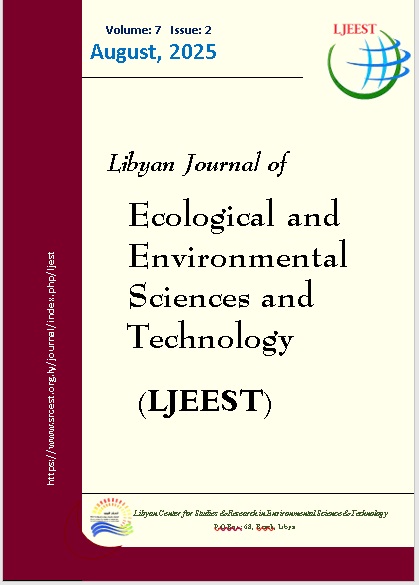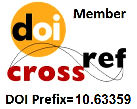Towards Environmental Sustainability: A Comprehensive Review of Electrochemical Methods for Remediating Heavy Metal Contamination in Soil and Water-Achievements, Challenges, and Prospects
DOI:
https://doi.org/10.63359/qrhp5b40Keywords:
Electrokinetic Remediation, Electrochemical Treatment , Heavy Metals, Water Remediation, Soil Remediation, Contaminant Removal Mechanisms, Electrode MaterialsAbstract
Heavy metal contamination of soil and water resources poses severe threats to environmental sustainability and human health. Electrochemical remediation technologies (ERT) have emerged as promising, versatile approaches for treating such contamination. This state-of-the-art review critically examines the fundamental mechanisms underpinning electrokinetic remediation (EKR) for soil and electrochemical treatment (ECT) for water, including electromigration, electroosmosis, electrophoresis, and electrolytic redox reactions at electrodes. We synthesize recent advances in their application for removing common heavy metals (e.g., Pb, Cd, Cr, As, Cu, Zn, Hg). Field-scale demonstrations and hybrid systems (e.g., coupling with permeable reactive barriers, phytoremediation, or chemical enhancement) are highlighted, showcasing enhanced efficiency and broader applicability. Despite significant progress, critical scale-up challenges persist, including energy consumption optimization, managing soil heterogeneity and groundwater flow, electrode stability and cost, secondary waste management, and regulatory acceptance. This review identifies key knowledge gaps and provides targeted recommendations for future research, emphasizing the need for integrated pilot studies, advanced electrode materials, renewable energy integration, standardized performance monitoring protocols, and techno-economic analyses to bridge the gap between laboratory success and widespread field implementation.
References
Acar, Yalcin B., and Akram N. Alshawabkeh. 1993. “Principles of Electrokinetic Remediation.” Environmental Science & Technology 27(13):2638–47. doi: https://doi.org/10.1021/es00049a002.
Ali, Hazrat, Ezzat Khan, and Muhammad Anwar Sajad. 2013. “Phytoremediation of Heavy Metals—Concepts and Applications.” Chemosphere 91(7):869–81. doi: 10.1016/j.chemosphere.2013.01.075.
Arora, Vaishali, and Babita Khosla. 2022. “Conventional and Contemporary Techniques for Removal of Heavy Metals from Soil.” in Biodegradation Technology of Organic and Inorganic Pollutants. IntechOpen.
Chowdhury, Farah Noshin, and Md Mostafizur Rahman. 2024. “Source and Distribution of Heavy Metal and Their Effects on Human Health.” Pp. 45–98 in Heavy Metal Toxicity: Human Health Impact and Mitigation Strategies. Springer.
Fernández-Marchante, C. M., F. L. Souza, M. Millán, J. Lobato, and M. A. Rodrigo. 2022. “Can the Green Energies Improve the Sustainability of Electrochemically-Assisted Soil Remediation Processes?” Science of The Total Environment 803:149991. doi: 10.1016/j.scitotenv.2021.149991.
Fertu, Daniela Ionela, Laura Bulgariu, and Maria Gavrilescu. 2024. “SUSTAINABLE USE OF SOME NATURAL MATERIALS AND WASTE FOR THE DECONTAMINATION OF ENVIRONMENTAL COMPONENTS POLLUTED WITH HEAVY METALS.” Environmental Engineering & Management Journal (EEMJ) 23(8). doi: 10.30638/eemj.2024.126.
Ghosh, Mridul, and S. P. Singh. 2005. “A Review on Phytoremediation of Heavy Metals and Utilization of It’s by Products.” Asian J Energy Environ 6(4):214–31.
Ho, Sa V, Christopher Athmer, P. Wayne Sheridan, B. Mason Hughes, Robert Orth, David McKenzie, Philip H. Brodsky, Andrew M. Shapiro, Timothy M. Sivavec, Joseph Salvo, Dale Schultz, Richard Landis, Ron Griffith, and Steve Shoemaker. 1999. “The Lasagna Technology for In Situ Soil Remediation. 2. Large Field Test.” Environmental Science & Technology 33(7):1092–99. doi: 10.1021/es980414g.
Lamma, O. A., A. M. Mohammed, and H. A. A. Aljazwei. 2020. “Studying Altitude Influence on Uludağ Fir Soil Macro Nutrients in Kastamonu.” International Journal of Research in Agronomy 5(1):43–48.
Li, Ruixiang, Jinning Wang, Tian Li, and Qixing Zhou. 2023. “Recent Advances in Improving the Remediation Performance of Microbial Electrochemical Systems for Contaminated Soil and Sediments.” Critical Reviews in Environmental Science and Technology 53(1):137–60. doi: 10.1080/10643389.2022.2040327.
Liu, Jianli, Zhubing Hu, Fangfang Du, Wei Tang, Siting Zheng, Shanzhou Lu, Li-hui An, and Jiannan Ding. 2023. “Environment Education: A First Step in Solving Plastic Pollution.” Frontiers in Environmental Science 11. doi: 10.3389/fenvs.2023.1130463.
Masoud, Abduladheim Masoud Mohamed. 2017. “Kuzey Bakıda Yetişen Karaçamın Bazı Toprak Özellikleri Ile Toprak Organik Karbon ve Toplam Azot Miktarları ve Depolama Kapasiteleri Üzerinde Yükseltinin Etkisinin Araştırılması.”
Mishra, Sandhya, Ram Naresh Bharagava, Nandkishor More, Ashutosh Yadav, Surabhi Zainith, Sujata Mani, and Pankaj Chowdhary. 2018. “Heavy Metal Contamination: An Alarming Threat to Environment and Human Health.” Pp. 103–25 in Environmental biotechnology: For sustainable future. Springer.
Moghimi Dehkordi, Mohsen, Zahra Pournuroz Nodeh, Kamran Soleimani Dehkordi, Hossein Salmanvandi, Reza Rasouli Khorjestan, and Mohammad Ghaffarzadeh. 2024. “Soil, Air, and Water Pollution from Mining and Industrial Activities: Sources of Pollution, Environmental Impacts, and Prevention and Control Methods.” Results in Engineering 23:102729. doi: 10.1016/j.rineng.2024.102729.
Mohamed, A. M., F. A. Abdullah, M. A. Arqeeq, H. Ahallil, A. A. Ahmed, and A. A. Saeid. 2025. “Study of Some Physical and Chemical Characteristics of Different Soils in Some Valleys of Bani Walid Region, Libya.” Archives of Agriculture Sciences Journal 14–28. doi: 10.21608/aasj.2025.417745.
Mohammed, Abduladheim Masood. 2021. “Spatial Change of the Chemical and Physical Properties of the Soil.” Journal of Global Scientific Research 6(4):1274–84.
Ntsomboh-Ntsefong, Godswill, Kingsley Tabi Mbi, and Essubalew Getachew Seyum. 2024. “Advancements in Soil Science for Sustainable Agriculture: Conventional and Emerging Knowledge and Innovations.” Academia Biology 2(3). doi: org/10.20935/AcadBiol6264.
Ormeño-Cano, Natalia, and Jelena Radjenovic. 2024. “Electrochemical Removal of Antibiotics and Multi-Drug Resistant Bacteria Using S-Functionalized Graphene Sponge Electrodes.” Journal of Cleaner Production 470:143245. doi: org/10.1016/j.jclepro.2024.143245.
Page, Mary M., and Christopher L. Page. 2002. “Electroremediation of Contaminated Soils.” Journal of Environmental Engineering 128(3):208–19. doi: org/10.1061/(ASCE)0733-9372(2002)128:3(208).
Pamukcu, Sibel, and J. Kenneth Wittle. 1992. “Electrokinetic Removal of Selected Heavy Metals from Soil.” Environmental Progress 11(3):241–50. doi: org/10.1002/9781119670186.ch13.
Probstein, Ronald F. 2005. Physicochemical Hydrodynamics: An Introduction. John Wiley & Sons.
Puppala, Susheel K., Akram N. Alshawabkeh, Yalcin B. Acar, Robert J. Gale, and Mark Bricka. 1997. “Enhanced Electrokinetic Remediation of High Sorption Capacity Soil.” Journal of Hazardous Materials 55(1–3):203–20. doi: org/10.1016/S0304-3894(97)00011-3.
Reddy, Krishna R., and Supraja Chinthamreddy. 2004. “Enhanced Electrokinetic Remediation of Heavy Metals in Glacial till Soils Using Different Electrolyte Solutions.” Journal of Environmental Engineering 130(4):442–55. doi: org/10.1061/(ASCE)0733-9372(2004)130:4(442).
Rozas, F., and Marta Castellote. 2012. “Electrokinetic Remediation of Dredged Sediments Polluted with Heavy Metals with Different Enhancing Electrolytes.” Electrochimica Acta 86:102–9. doi: org/10.1016/j.electacta.2012.03.068.
Sadaf, Shoumik, Hridoy Roy, Athkia Fariha, Tanzim Ur Rahman, Nishat Tasnim, Nusrat Jahan, Adewale Allen Sokan-Adeaga, Safwat M. Safwat, and Md Shahinoor Islam. 2024. “Electrocoagulation-Based Wastewater Treatment Process and Significance of Anode Materials for the Overall Improvement of the Process: A Critical Review.” Journal of Water Process Engineering 62:105409. doi: org/10.1016/j.jwpe.2024.105409.
Salem, M. O. A., B. A. F. Abdalah, and A. M. Mohamed. 2024. “Synergistic Impact of Olive Waste on Some Soil Properties: A Comprehensive Review.” Archives of Agriculture Sciences Journal 7(3):23–29. doi: org/10.21608/aasj.2024.399395.
Salem, Mohamed Omar Abdalla, and Nisreen moftah Mohamed. 2025. “Heavy Metal Contamination in the Fruit of Date Palm: An Overview.” Journal of Bani Waleed University for humanities and Applied Science 10(1):165–79. doi: org/10.58916/jhas.v10i1.661.
Salem, Mohamed Omar Abdalla, and Ilyas Ammer Saeed Salem. 2023. “Detection of Heavy Metals in Goat Milk in Bani Waleed City-Libya.” Libyan Journal of Ecological & Environmental Sciences and Technology 5(2):69–73. doi: org/LJEEST/050213.
Sánchez-Castro, Iván, Lázaro Molina, María-Ángeles Prieto-Fernández, and Ana Segura. 2023. “Past, Present and Future Trends in the Remediation of Heavy-Metal Contaminated Soil-Remediation Techniques Applied in Real Soil-Contamination Events.” Heliyon 9(6). doi: org/10.1016/j.heliyon.2023.e16692.
Smarzewska, Sylwia, and Dariusz Guziejewski. 2021. “Soil Remediation Technologies.” Pp. 193–219 in Handbook of advanced approaches towards pollution prevention and control. Elsevier.
Srivastava, Himanshi, Pinki Saini, Anchal Singh, and Sangeeta Yadav. 2024. “Heavy Metal Pollution and Biosorption.” Pp. 1–38 in Biosorption Processes for Heavy Metal Removal. IGI Global.
Sun, Zeying, Miaomiao Zhao, Li Chen, Zhiyang Gong, Junjie Hu, and Degang Ma. 2023. “Electrokinetic Remediation for the Removal of Heavy Metals in Soil: Limitations, Solutions and Prospection.” Science of the Total Environment 903:165970. doi: 10.1016/j.scitotenv.2023.165970.
Tangahu, Bieby Voijant, Siti Rozaimah Sheikh Abdullah, Hassan Basri, Mushrifah Idris, Nurina Anuar, and Muhammad Mukhlisin. 2011. “A Review on Heavy Metals (As, Pb, and Hg) Uptake by Plants through Phytoremediation.” International Journal of Chemical Engineering 2011(1):939161. doi: org/10.1155/2011/939161.
Virkutyte, Jurate, Mika Sillanpää, and Petri Latostenmaa. 2002. “Electrokinetic Soil Remediation—Critical Overview.” Science of the Total Environment 289(1–3):97–121. doi: org/10.1016/S0048-9697(01)01027-0.
Yeung, Albert T. 2011. “Milestone Developments, Myths, and Future Directions of Electrokinetic Remediation.” Separation and Purification Technology 79(2):124–32. doi: org/10.1016/j.seppur.2011.01.022.
Zheng, Wukui, Tian Cui, and Hui Li. 2022. “Combined Technologies for the Remediation of Soils Contaminated by Organic Pollutants. A Review.” Environmental Chemistry Letters 20(3):2043–62. doi: 10.1007/s10311-022-01407-y.
Downloads
Published
Issue
Section
License
Copyright (c) 2025 Libyan Journal of Ecological & Environmental Sciences and Technology

This work is licensed under a Creative Commons Attribution-NonCommercial 4.0 International License.















